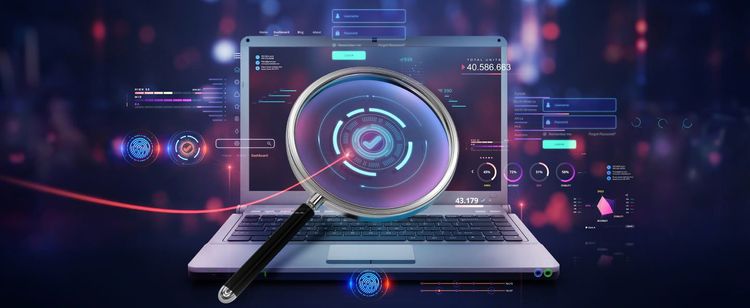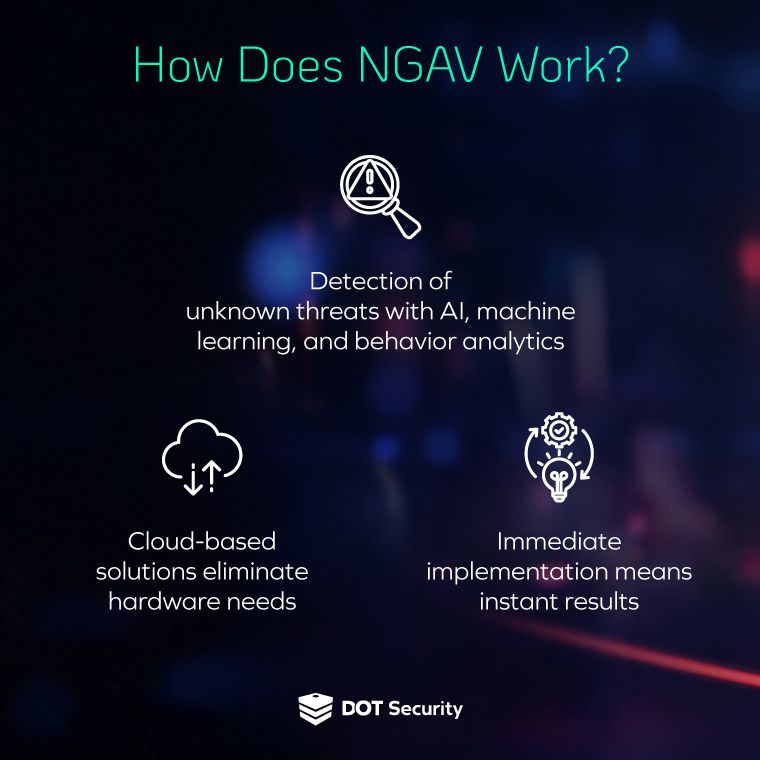Edge Security
What is Next-Gen Antivirus?
February 22, 2024
8 minute read

Next-generation antivirus (NGAV) software takes traditional antivirus to the next level, using cutting-edge technology, including machine learning and artificial intelligence, to identify and eliminate threats to your business.
NGAV software takes an algorithmic approach to device protection that examines processes, data, application usage, network activity, and user behavior to help spot unusual activity.
In contrast, a traditional antivirus relies on programmers to identify an attack after it has hit and reactively patch the vulnerabilities in your platform with an update.
Sign up for our newsletter!
The main difference here is that next-gen antivirus software's are proactive, whereas legacy antivirus systems are very reactive. You can greatly enhance your organization’s cybersecurity today by embracing the defensive power of NGAV.
How effective is your current approach to cybersecurity? Use our checklist, How Covered is Your Business, to help you identify the weak points in your security strategy and what technologies, tools, and policies you need to stay secure.
Understanding How NGAV Works
Next-generation antivirus uses a combination of modern technology, machine learning, and artificial intelligence to improve threat detection efficiency, incident response time, and length of recovery.
NGAV is a more proactive approach to cybersecurity that can identify network usage trends and learn from past breaches, attacks, and vulnerabilities to improve security protocols moving forward.
NGAV also makes use of investigative tools that allow the software to analyze the structure, behavior, and programming logic of threatening programs before they’re executed on your systems. By using these technologies in concert, next-generation antivirus provides you with the strongest safety filter available.
Why Next-Gen Antivirus is Crucial for Businesses
Over the past few years, there has been a steady rise in both the number and severity of cyberattacks. From ransomware attacks to phishing scams, to long-term social engineering schemes like pig butchering, the surge in cyberthreats has made next-generation antivirus a necessity.
Staying ahead of cybercriminals is a tremendous challenge for businesses of all sizes but is especially difficult for those without strong cybersecurity strategies and protocols in place.
With cybercrime on the rise, one thing is for sure: the traditional "set it and forget it" approach that legacy antivirus software takes simply is not enough anymore.
Next-generation antivirus is how businesses can protect themselves against newly developed cyberattacks that would slip past legacy antivirus solutions. This has to do with the way that legacy antivirus was designed to recognize known threats. The problem though, is that legacy solutions have no way of identifying new threats.
Why NGAV Over Legacy Antivirus Software
Modern cybercriminals regularly invent new attacks specifically designed to defeat systems with known flaws that, if old enough, are no longer being actively patched and fixed. These new threats know exactly what vulnerabilities to target, can quickly identify system weaknesses, and proceed to easily infiltrate a business’ network.
Additionally, business systems are becoming much more complex than legacy antivirus software was originally designed to defend. Now we have remote workers (logging in from multiple devices on different networks), cloud-based data, more connected devices, the internet of things, and a slew of other tech-based solutions that organizations employ.
Traditional antivirus takes a signature-based approach, meaning it scans files for identifiers that match known viruses. However, modern-day attackers know how to disguise malicious code to bypass these defenses. Using new techniques, cybercriminals can introduce malware without adding new files onto a system or through code that periodically changes to remain undetected by signature-based detection methods.
NGAV software focuses on using network events to identify malicious intent, behavior, and activity when compared to the typical network activity on any given day.
Benefits of Next-Generation Antivirus
The biggest difference between traditional antivirus and NGAV is that the latter takes a proactive approach to protection opposed to a reactive one.
The number of endpoints existing on business networks is consistently growing and is now much higher than it was just years ago. Simply put, a traditional antivirus can’t keep up.
A next-gen antivirus solution looks for file signatures, similarly to a traditional antivirus, but it also detects attacks by scanning for events, processes, and connections to seek out inconsistencies and irregularities within your network.
This makes it significantly harder for modern attacks to successfully get into your network.
NGAV software is a modern tool for modern cyberthreats. It takes system security above and beyond anything a legacy antivirus software could offer. One of the biggest benefits of investing in NGAV security is that it’s capable of detecting both known and unknown threats.
Through its use of sophisticated technologies, like machine learning and AI, NGAV programs can successfully identify new malware even if it uses a disguising protocol to hide its identifiable features in the programming.
Significantly improved efficiency is another major benefit that NGAV programs bring to your organization. This efficiency stems from a few sources, including more readable reports, cloud-based services that allow for super quick downloads, automatic updates, and seamless system integration.
High-quality next-generation antivirus programs also minimize downtime and dwell time in the event of a successful cyberattack.
Here are a few more ways that a modern NGAV program takes cybersecurity to the next level:
- Machine Learning: An automated process in which a bot scans files for malware.
- Behavior Analysis: Processes are monitored in order to detect abnormalities that could be the result of cyberattacks.
- Threat Intelligence: When a threat is detected, every device on the network is updated to help counter additional danger and to stop the spread.

Do You Need Next-Gen Antivirus?
The world of cybersecurity in business is changing. If your antivirus isn’t changing with it, then your business is in danger. Many organizations are marked as a prime target for cyberattacks because they're using outdated antivirus solutions and relying on a subpar cybersecurity posture.
It doesn't help that so many decision-makers are under the dangerous assumption that cyberattacks are mostly aimed at large corporations in the Fortune 500, which couldn’t be further from the truth.
Not only are cyberattacks launched against businesses of all sizes, but unprepared organizations may not have the budget or solutions in place to recover from a major breach.
One of the main challenges all organizations face is endpoint security. Rather than having a handful of computers accessing a network, modern businesses have hundreds of phones, tablets, laptops, and other smart devices running on their network every single day.
This means many potential points of attack present a serious security issue for businesses without a cybersecurity strategy and emphasizes the need for a proactive approach toward security that includes a next-generation antivirus solution.
Choosing Your NGAV Solution
Now that we’ve reviewed how next-generation antivirus works, the benefits it brings to the business, and why it’s better suited for modern cybersecurity strategies than legacy antivirus software is, let’s review a few of the key functions and capabilities you want to look for when selecting an NGAV solution.
One of the most important considerations to take into account when shopping for a next-generation antivirus is how effectively it adapts to evolving cyberattack tactics and techniques. A high-quality NGAV protects your network from cyberattacks that leverage commodity malware, zero-day exploits, or even sophisticated malware-free attacks.
There are four pillars of next-gen antivirus that your solution needs to cover:
1. Malware Defense
NGAV employs sophisticated methods to identify and mitigate potential threats across your network. Unlike conventional antivirus solutions, NGAV uses machine learning and behavior analysis to identify threats, rather than predefined signatures.
This proactive approach enables next-generation antivirus to adapt and evolve, continuously learning from past encounters to anticipate and neutralize both new and emerging threats. By carefully monitoring network activity, NGAV discerns any unusual or suspicious behaviors that indicate malicious intent.
All-in-all, machine learning and behavior analytics in next-generation antivirus software strengthen system defenses by seeking out, identifying, and blocking existing and new-aged malware.
2. Preventing Malware-Free Cyberattacks
While malware defense is a major component of NGAV, not all cyberattacks make use of traditional malware attacks. This is why it’s important that the next-generation antivirus you choose actively looks for attack indicators that hint at malicious activity.
Powered by machine learning and powerful online algorithms that deliver real-time analysis of potential threats helps you get in front of newly developed cyberattacks that don’t yet carry an identifying signature or use a malware-delivery system.
3. Threat Intelligence and Analysis
Threat intelligence and analysis is the brain behind NGAV and enables these solutions with tools and tactics designed for an immediate response to network threats and cyberattacks.
Simply put, threat intelligence is how next-generation antivirus solutions determine the origin and severity of cyber threats, as well as how they can best be mitigated or neutralized.
The ability to identify threats and predict their impact allows your organization to create response priorities and maintain a healthy, uncompromised network.
4. Cloud Compatible
Next-generation antivirus solutions become even more powerful when they’re integrated with the cloud.
By integrating NGAV with the cloud, it gains access to a huge library of threat intelligence and data analytics it can learn from to address modern cyber threats. By leveraging the cloud, NGAV can access the latest information about emerging threats and adapt defenses accordingly.
Additionally, cloud-based networks facilitate seamless collaboration and information sharing among NGAV protocols and response instances, enhancing overall threat detection and response capabilities across any working environment.
Wrapping Up on Next-Generation Antivirus
Next-generation antivirus solutions enhance your cybersecurity by identifying a malicious network presence, combatting malware installations, and adapting to new-aged cyberattacks in real-time.
Keeping up with the latest cybersecurity threats can be difficult for businesses that don’t have large internal IT or cybersecurity teams. This is dangerous because cybercriminals are always adapting the way they attack networks, so without updated defenses in place and modern next-generation antivirus solutions, businesses are leaving themselves vulnerable to all sorts of new attacks.
To see how covered your business is from modern cyberattacks, check out our checklist, How Covered is Your Business which will help walk you through the required security elements businesses should have to stay secure.
